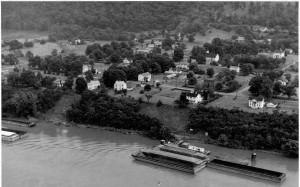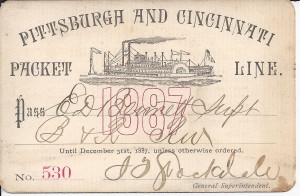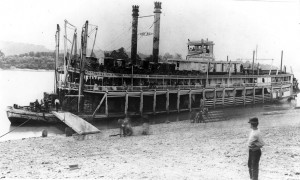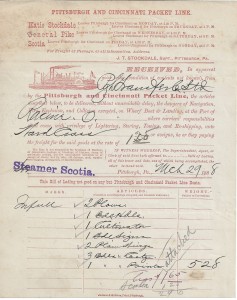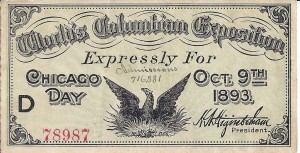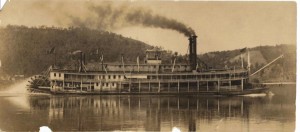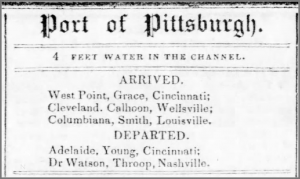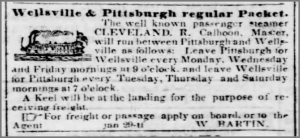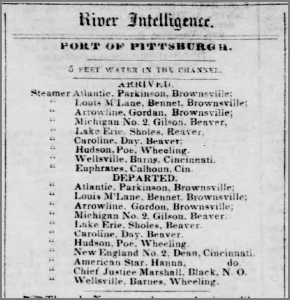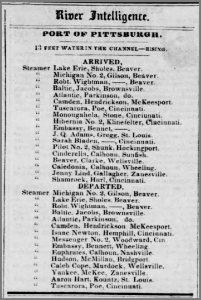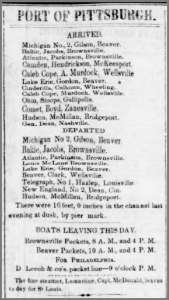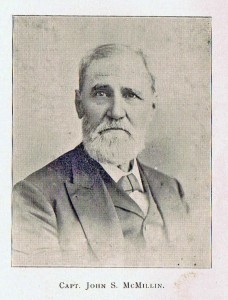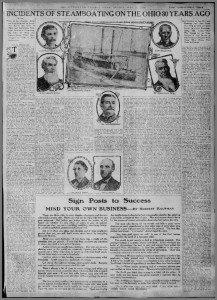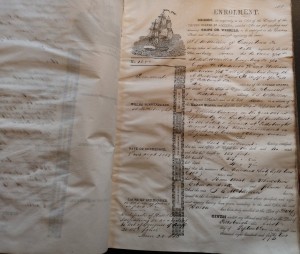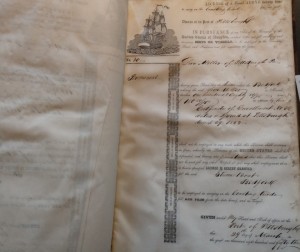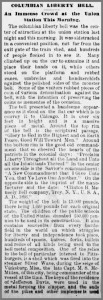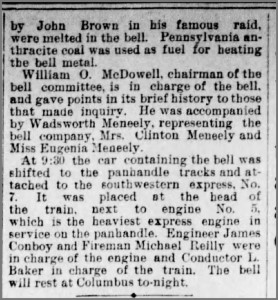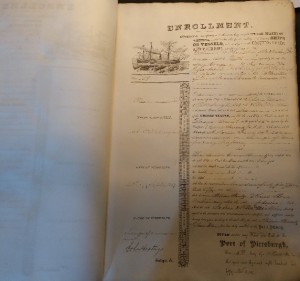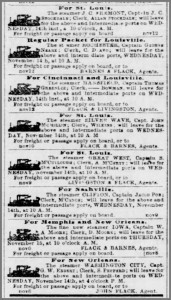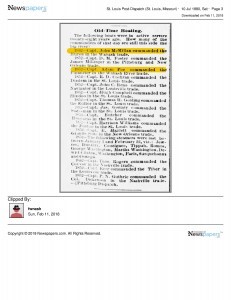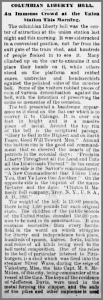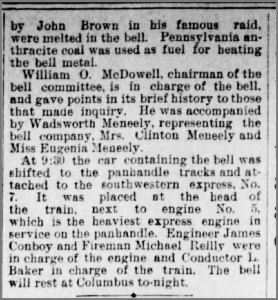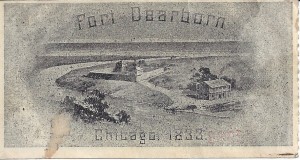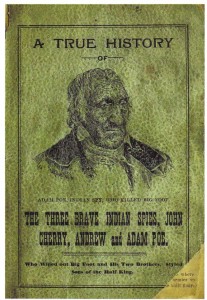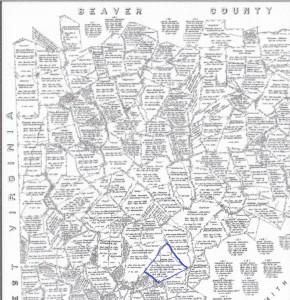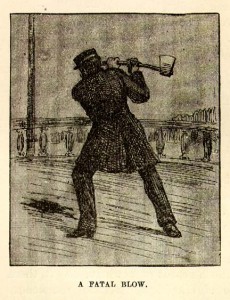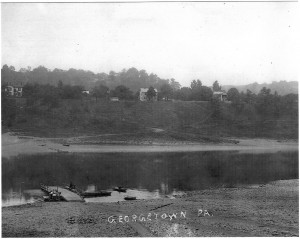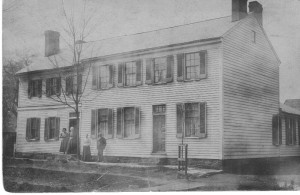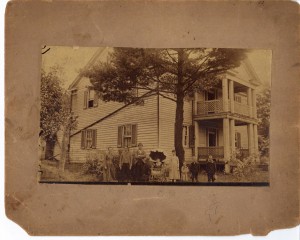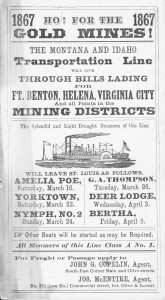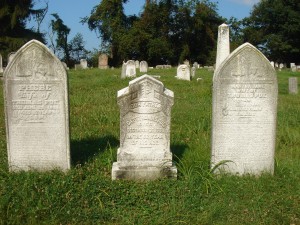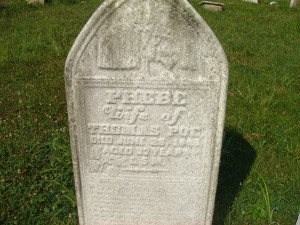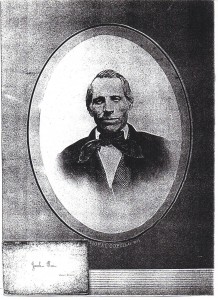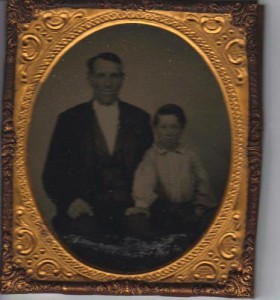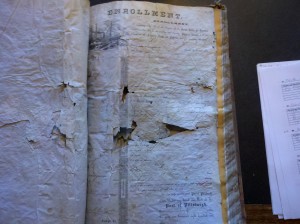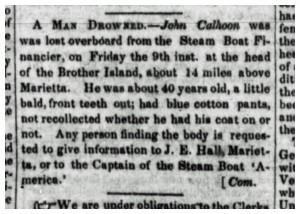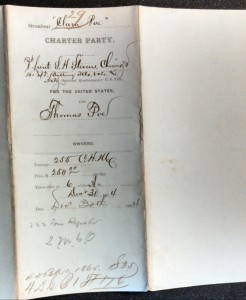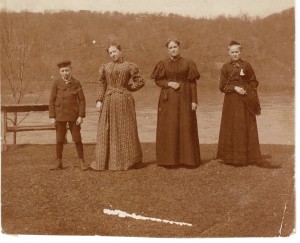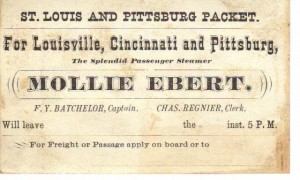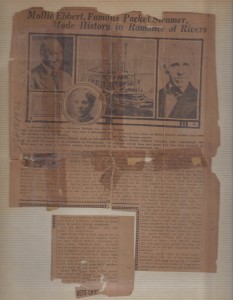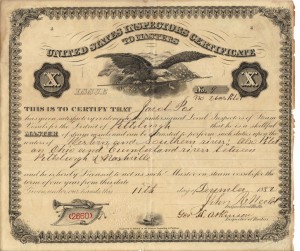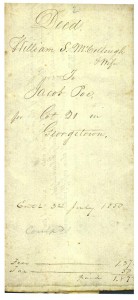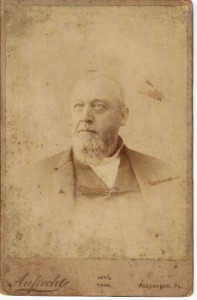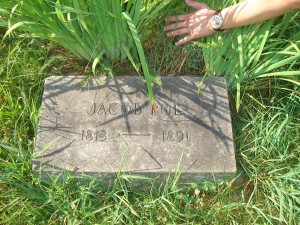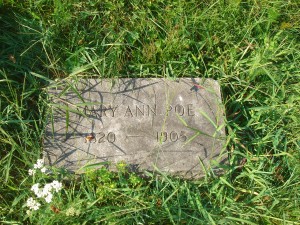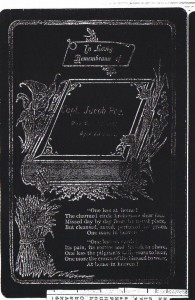The Waterway of the World
The Motto of the
Pittsburgh and Cincinnati Packet Line
“Finally, the quality of the boats used and the efficient service rendered has never been excelled on the upper Ohio. To this day one needs only to mention the names Thomas S Calhoon, J Frank Ellison, and Charles W Knox, commanders of the “Second” Pittsburgh and
Cincinnati Packet Line, to revive the best river traditions of the Ohio River… The steamboatmen of this period are the pride and boast of the inland waters. In courtesy they had few if any superiors; in efficiency and accomplishments they were surpassed, among rivermen, only by their contemporaries, “the coal barons”. For a generation or more the richest river annals of America have been the stories of their deeds and achievements… From their biographies and those of their contemporaries who have passed on in the last generation could be written important chapters in the story of our national development.” [1]
No finer tribute could be penned. In 1932 Charles Henry Ambler, an honored professor of history and prolific author, wrote that description of the Pittsburgh and Cincinnati Packet Line and its steamer captains: [2] History does not come neatly packaged. What follows is not a full history of the Pittsburgh and Cincinnati Packet Line, or even all of the of men mentioned in it. It is, rather, the story of a collection of people whose paths put them on the Ohio River during a time of the great titans of industry.
The Beginning.
Some fifty-five years earlier in Nov 1877 while the steamer Katie Stockdalewas being built, Jackman Taylor Stockdale and Thomas
Stevenson Calhoon were actively engaged in organizing the Pittsburgh and Cincinnati Packet Line. Thomas S Calhoon was the nephew of Jackman T Stockdale. This uncle-nephew combination were partners in many river transportation enterprises since before the Civil War. Capt Thomas S Calhoon and Capt Jackman T Stockdale were also neighbors living within foot distance of each other and the Georgetown Landing. Both built homes in Georgetown, PA with large picture windows and second story porches overlooking the Ohio River. Both had long careers in Ohio River commerce. [3] Both served during the Civil War as masters of civilian transports moving troops and supplies on the western rivers. They were Union men. Their loyalties were deeply felt. The str Horizon, ownership which they shared, sunk on Island No 10 near Grand Gulf, MS on 1 May 1863. Loaded with troops and supplies, the Horizon had been ordered to steam down the Mississippi past the batteries at Vicksburg. Running after dark on a moonless night without lights, making evasive moves, badly riddled by rebel cannons, the Horizon was not in serious trouble until the collision with the Moderator. The Moderatorhad been damaged to the degree that it was unmanageable. Both vessels sunk. Reports differ on the number of troops lost. After the Civil War Capt Jackman Stockdale moved his
family to Allegheny City taking his “Georgetown spirit” with him. Capt Thomas S Calhoon lived all his life in Georgetown and was laid to rest next to his wife in Georgetown Cemetery looking down from the hilltop setting to his home and Georgetown Landing. If such a place could ever be described as charming, this cemetery surely could. The whole area takes on the appearance of a well-kept park. Certainly, anyone buried in the Georgetown Cemetery was at least half-way to his or her final reward.
The Pittsburgh and Cincinnati Packet Line was the imaginative forward-looking concept of river commerce of Jackman T Stockdale and Thomas S Calhoon. The prime feature of the concept was luxurious river passenger travel service. The deluxe packets, from their crystal chandeliers and gilt trimmed mahogany cabins to their fancy topped stacks, were designed to cater to high class patrons. The first officers of the newly organized Pittsburgh and Cincinnati Packet Linewere Jackman T Stockdale (Superintendent with offices in Pittsburgh), James A
Henderson (Steamboat agent with offices in Pittsburgh), Charles M Fairman (Steamboat Agent with offices in Cincinnati), and Thomas S Calhoon (Master of the str Katie Stockdale). [4] The str Katie Stockdale was the first deluxe packet of the line.
Confusion clouds the original name of the packet line. The line name on a letterhead found on correspondence dated Nov 1878 was the Pittsburgh, Wheeling, & Cincinnati Packet Line. Later letterheads eliminated Wheeling as a destination of the line name and so the name Pittsburgh and Cincinnati Packet Line (PCPL) was settled on. In a few years, it would become the most luxurious line on the inland waterways. Often this packet line is referred to in print as the “second” Pittsburgh and Cincinnati Packet Line. The “first” PCPL had been established in 1842 by William Thaw, Thomas Shields Clarke, and others. The “first” PCPL faded from existence before the Civil War. [5]
The National Scene.
In 1878 as the PCPL was being organized, the nation was beginning to recover from the Long Depression which started with the Panic of 1873. This financial crisis marked the entire second term of US Grant’s Presidency. [6] One of the causes of the severe nationwide economic decline was the extreme over-expansion of the nation’s railway system. Speculative investments in railroads had been driven by generous government land grants and subsidies to railroads. Even with government support, sixty of the nation’s railroads went bankrupt in the first year of the panic. Banks with significant railroad investments also failed. In general, the post-Civil War economy was one of unregulated growth with the government playing no role in curbing banking and manufacturing abuses. Think of the men who were to form the new nobility of industry and banking during this period. They reached their manhood when President Lincoln issued his first call for volunteers during the Civil War: Philip Armour (Beef and Pork in Chicago), Andrew Carnegie (Steel in Pittsburgh),” Diamond Jim” Fisk (Stockbroker and Erie RR in NYC), Jay Gould (Erie and Northwest RRs), James Hill (Coal and Great Northern RR in St Paul), JP Morgan (Banking and RRs in NYC), and John Rockefeller (Oil Cleveland). All of these “robber barons” bought substitutes to serve in their behalf during the Civil War. [7] In addition to vulgar wealth accumulation and the ruined fortunes of many American families, it was also time of the origin of bitter animosity between workers and business leaders. Think of the workers targeted by the new nobility: steel and rail workers maimed and killed, coal miners burned in their homes with their families, and workingmen jailed, beaten, or deported. It was in historical setting, this thunder cloud of gloom, that the PCPL was founded.
The Gilded Age of River Travel.
The packets comprising the first fleet of the PCPL, steamers Katie Stockdale, Emma Graham, Granite State, WP Thompson, and Buckeye State, were new luxurious boats giving the line a good start. [8] The information about the packets listed below include their build date and the departure day from the ports of Pittsburgh and Cincinnati. [9] In addition to well-heeled passengers, these packets also transported finished steel from the Carnegie Steel mills along with other regional products, such as fine glass, coal, and pottery.
PCPL Fleet in 1879
| Packet | Build date |
DateDepart PittsburghDepart Cincinnati
Katie Stockdale1877MonThu
Emma Graham1877WedSat
Granite State1870FriSun
Buckeye State1878??
WP Thompson1876??
The str Katie Stockdale was the first boat built expressly for the PCPL at a cost of $33,561.65 in 1877. [10] Capt Thomas S Calhoon was long her master on the Saturday run to Cincinnati. As newer and more luxurious boats entered the fleet of the PCPL, the Katie Stockdale became the Monday boat from Pittsburgh. A round trip fare for one passenger, Pittsburgh to Cincinnati as advertised, was $10. After a long and prosperous career, in 1890 the Katie Stockdale was dismantled in Marietta, OH and much of her machinery including her whistle and roof bell was removed and installed in the new sternwheeler Keystone State. [11] Capt Thomas S Calhoon commanded the Katie Stockdale her entire 13 years. He was her only master.
In 1883, the letterhead for the PCPL listed four boats in service. [12] All were grand packets of the day.
PCPL Fleet in 1883
| Packet | Depart Pittsburgh | Depart Cincinnati |
| Katie Stockdale | Mon | Thu |
| Emma Graham | Wed | Sat |
| Scotia | Fri | Mon |
| Hudson | Sun | Wed |
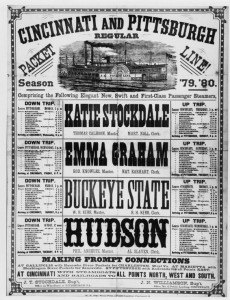
Pittsburgh and Cincinnati Packet Line Advertisement dated 1879-80 (From the Collection of The Public Library of Cincinnati and Hamilton County.)
Over and above the normal passenger and freight service the str Katie Stockdale commanded by Capt Thomas S Calhoon led a special relief effort for the victims of the Flood of 1884. This incredible story begins with a summons to Capt Thomas S Calhoon to get back to his boat which he had tied up in Cincinnati when the Ohio River stage was 16 feet. It was 40 feet and rising when the summons arrived. There was no general alarm because the Flood of 1883 had topped at 66 feet 4 inches in Cincinnati. When Capt Calhoon stepped aboard the Katie on Sunday, 3 Feb, the river was at 46 feet. Rising and raining. Fear and anxiety. No doubt a major flood was coming. [13]
The situation was alarming and yet Capt Calhoon decided to run the 470 miles to Pittsburgh breasting the flood. All the tributaries of the Ohio for a thousand miles were flooding at the same moment. Marks showed 57 feet and rising four inches per hour in Cincinnati. It was a mournful day in Cincinnati. The city was fighting to save life if it could not save property. Business was entirely suspended in Pittsburgh. [14] Although the river full of floating ice and not another steamer was stirring, Capt Calhoon’s biggest concern was whether the Katie Stockdale could get under the railroad bridge at Pt Pleasant, WV. Even with stacks lowered, the bridge when sighted was going to take the top of the pilot house. Capt Calhoon ordered the boat’s carpenter to take off the top of the pilot house. (Another source indicated that the pilothouse was sawed off level with the pilot’s wheel on 10 Feb 1884 to get under the Parkersburg bridge.) When the roof was dismantled, the pilots, Billy Abrams and his partner Halloway, aimed the Katie at the center of the span. Afterwards it was told, that the pilot’s wheel raked cobwebs from the bridge’s underspan. The pilots had counted 120 houses bobbing by that one day. [15]
When the Katie Stockdale blew her landing whistle at the Point Bridge in Pittsburgh, the flood crest had passed. The crest on 14 Feb in Cincinnati was 71 feet 12 inches. [16] The Ohio River valley from Wheeling to Cairo was a major disaster.
After the fairly risky trip up the Ohio, Capt Calhoon was summoned to the wharfboat for a conference. His partner Capt Jackman T Stockdale introduced him to Col Samuel Cushing of the US Army. The US Congress had appropriated $300,000 for Ohio River flood relief of which $60,000 had been allocated to Col Cushing. The Katie Stockdale under orders of the US Army was quickly loaded with supplies. Then Capt Calhoon was in command of the distribution of the supplies. With 300 tons of freight aboard the Katie Stockdale began downriver on 10 Feb. [17]
The devastation was horrific. Capt Calhoon was under orders to deliver relief to the towns between Wheeling and Ironton, OH.
At the trip’s conclusion, decks bare, the Katie steamed into Pittsburgh on George Washington’s birthday. Mission accomplished. The effort of the Katie Stockdale was the first instance of federal purchase and distribution of flood relief supplies along the inland rivers. [18]
In 1886, the officers of PCPL fleet included:
PCPL Fleet in 1886
| Packet | Captain | Clerk |
| Katie Stockdale | TS Calhoon | Charles W Knox |
| Scotia | George W Rowley | Robert H Kerr |
| Hudson | JF Ellison | AJ Slaven |
The PCPL fleet never had less than three packets at work.
On 8 Jun 1887, Capt Jackman T Stockdale died suddenly and unexpectedly at age fifty-nine. [19] After some time, James A Henderson, who had been Capt Jackman T Stockdale’s chief assistant in the Pittsburgh offices, and his brother-in-law, George WC Johnston, bought a controlling interest in the line. The Pittsburgh and Cincinnati Packet Line was reorganized in 1889 bearing the same name and listing its officers as follows:
PCPL Officers in 1889
| Officer | Position |
| James A Henderson | President and General Manager |
| Thomas S Calhoon | Vice president |
| George WC Johnston | Secretary and Treasurer General Freight and Passenger Agent |
| Alex J Henderson | Assistant Superintendent |
| John Crockard | Agent – Wheeling, WV |
| J Frank Ellison | Superintendent – Cincinnati |
In 1889 as the Keystone State was being built for Thomas Stevenson Calhoon and the str Katie Stockdale was being dismantled, the steamer Rainbow was chartered by the PCPL. On 10 Mar 1890, the Congo was chartered to replace the Rainbow which had unfortunately burned while laid up for low water near Cincinnati.
At this time a round trip fare, Pittsburgh to Cincinnati, was $12 ─ meals included. A round trip fare to the World’s Fair in Chicago in 1892 and 1893 was $18. The dedication ceremonies for the World’s Columbian Exposition were held on 21 Oct 1892 and the fair continued until 30 Oct 1893. That people preferred to travel by packet is noteworthy ─ beyond what is usual or established history in the age of railroads.
In 1890, Capt Calhoon built the Keystone State for the PCPL. Capt Calhoon was her master for 5 years. When Capt John N Philips resigned command of the Iron Queen, Capt Calhoon succeeded him. He was aboard the Iron Queen for only three trips before she was destroyed by fire.
PCPL Fleet in 1892
| Packet | Depart Pittsburgh | Depart Cincinnati |
| Keystone State | Mon | NA |
| Scotia | Tue | NA |
| Hudson | Wed | NA |
| Iron Queen | Fri | NA |
| CW Bachelor | Sat | NA |
In 1893 the PCPL was incorporated. Its charter was registered in West Virginia and its capital stock, owned mostly be the executives and captains, was valued at $200,0000. [20] The officers and stockholders are listed in the following table.
PCPL Officers in 1893
| Officer | Position |
| James A Henderson | President and General Manager |
| George WC Johnston | Secretary and Treasurer |
| J Frank Ellison | Superintendent – Cincinnati |
| Cat Thomas S Calhoon | Stockholder |
| Capt Thomas M Rees | Stockholder |
| Capt John M Philips | Stockholder |
The PCPL packets and officers in 1893:
PCPL Fleet in 1893
| Packet | Captain | Purser |
| Keystone State | Thomas S Calhoon | Charles W Knox |
| Scotia | Mace Agnew | Daniel M Lacey |
| Hudson | Robert S Agnew | AJ Slaven |
| Iron Queen | John M Philips | RH Kerr |
| CW Bachelor | JM Keever | George W Hunter |
| Andes | Thomas Hunter | AJ Slaven |
The PCPL packets and officers in 1894:
PCPL Fleet in 1894
| Packet | Captain | Purser |
| Keystone State | Thomas S Calhoon | Charles W Knox |
| Scotia | GE Rowley | Tim Penwell |
| Hudson | J Frank Ellison | DM Lacey |
| Iron Queen | John M Philips |
TS CalhoonRH KerrCongo Ed F MaddyJ WehrmanAndes Thomas HunterAJ Slaven
The Iron Queen went up in flames on 3 Apr 1895 while Thomas Stevenson Calhoon was in command. The steamer LA Sherley with Capt Ed F Maddy and J Wehrman in the office was chartered to replace the Iron Queen until the completion of the Virginia which was launched in Dec 1895. The Virginia with Capt Thomas S Calhoon in command came out on New Year’s Day 1896. [21]
The PCPL packets and officers in 1896:
PCPL Fleet in 1896
| Packet | Captain | Purser |
| Keyston State | Charles W Knox | |
| Queen City | Thomas S Sandford | Daniel M Lacey |
| Virginia | Thomas S Calhoon | RH Kerr |
| Hudson |

Capt Thomas S Calhoon (left) aboard the Virginia 1896 (From the Collection of The Public Library of Cincinnati and Hamilton County)
These were the glory days of the PCPL The luxury of Queen City and her sister the Virginia were unmatched. By design these two deluxe packets catered to a rather high class patronage. Both were advertised in the Pittsburgh social register, to great advantage, as many fashionable Pittsburghers trod their decks. Both made annual trips to the Mardi Gras with great success. The minutes before departure of a PCPL boat always had a somewhat carnival air. Men were dressed in topcoats and silk hats; women wore outfits made complicated by bustles. All this while roustabouts performed their ballet of loading barrels and boxes.
The str Virginia was the ultimate in luxurious travel. Before the Broadway Limited of railway fame, the Virginia cruise from Pittsburgh to Cincinnati was a trip of breathtaking elegance and adventure. The cabin was 190 feet long with 50 state rooms. Each state room had an upper and lower berth. The mattresses, sheets, and pillows and linens were proved by Joseph Horne and Co, the famed department store in Pittsburgh. An upright piano in the ladies’ cabin was provided by Kappel Music House. The full-length hallway was also used as the dining area. Tables could be finely set for 120 passengers and officers. [22]
The Virginia built in 1896 and the Queen City built in 1897 at the same Cincinnati boatyard were similar in size, appearance, and capacity. However, they were not alike in appeal. According to George W Henderson in 1962, the family favorite was the Virginia. The Queen City had class; the Virginia had charm. [23]
In 1898, the PCPL declared an annual dividend of nine per cent. Nearly every trip made a profit. [24]
The PCPL packets and officers in 1904.
PCPL Fleet in 1904
| Packet | Captain | Purser |
| Keyston State | Charles W Knox | |
| Queen City | Thomas S Sandford | |
| Virginia | Thomas S Calhoon | |
| Hudson |
Thomas S Calhoon retired from the river in 1904 at age 70. His career spanned 56 years from his first trip aboard his Uncle Richard Calhoon’s steamer Caledonia to his final voyage on the Virginia. [25] He was one of the few Georgetown river men who stayed until the river commerce disappeared and nothing was left but the scenery. He died at his home in Georgetown on 3 Apr, 1910 at 11:30 in the morning after a short illness.
The Decline.
The opening of the 20th Century pointed to continued prosperity for Ohio River commerce. The years preceding were record breakers as far as tonnage carried. Tonnages in bulk traffic: coal, lumber, grain, sand and gravel, and steel, improved while regular passenger packets held their own. The fleet was the most luxurious ever assembled. In 1905 two million passengers traveled the Ohio. [26] Nonetheless the Ohio River transportation system entered a period of decline. Evidence was abundant. In 1908 PCPL was forced into receivership. It continued to operate until 1912 when its assets were sold to John W Hubbard of Pittsburgh bringing twenty-two thousand two-hundred dollars ─ one-fifth of their appraised value. [27] After that, one could travel along the upper Ohio for a full day and never see a steamboat. [28] The Ohio River was as dead as a church on Monday morning. Not only were steamboat owners and their crew financially harmed, the entire steamboat building economy was destroyed along with all the support businesses located at or near the wharfs and boatyards.
The causes of this decline were numerous and no one of them was powerful enough to cause destruction so complete and so quickly. In those early years of the twentieth century, the permanent characteristics of the US were being hardened. Giant corporations were growing in power; benign government regulation was supported by businessmen and Presidents; the wobblies (IWW) organized; etc. The fact that European river traffic was increasing to the benefit of railroads there was ignored by those in favor of the total transition to railroads here.[29] The blame of the decline has largely been fixed to the greed of railroad barrons who owned the river terminals and facilities and refused to cooperate with river lines on prorating freight arrangements as they had in the 1890’s. In other words, a packet could no longer discharge its freight and passengers at a port without excessive fees: wharfage and way charges which were so prohibitive that landings became unprofitable. Packet lines making many intermediate stops were effectively taxed out of existence. Most prorating arrangements between packet lines and railroads had been withdrawn around 1900.
Probably the single most effective blow to the PCPL PCPL was the formation of United States Steel Corporation (USS) in 1901. USS was the former Carnegie Steel Company purchased and renamed by JP Morgan.
USS made a corporate decision to ship their products by rail only regardless of the freight rates. JP Morgan had control of more than twenty railroads and held significant influence over members of the US Congress. At that time river rates were regulated by the Interstate Commerce Commission (ICC). Strangely, the ICC’s rulings pertaining to fair rates for freight transfer at railroad junction points were not applicable to rail and river junction points. And “inventive genius and the business talent of the country” were drifting toward the railroads according to one Congressional oversight committee. [30] A key assumption in this inversion was that railroads deserved government support while river transportation did not. The deck was stacked doubly against the packet lines.
The PCPL never operated less than three packets moving iron and steel and glass south and farm products and whiskey north. Financial success depended on both freight and passenger traffic. Under the existing conditions in 1908, and in some instances unscrupulous forces, the rivermen were unable to carry on.

The Virginia passing under the Wabash Bridge note the stacks (From the Public Library of Cincinnati and Hamilton County.
And so the days of PCPL were over. The packets built expressly for the PCPL had been the best of their day. Style and luxury were their key features: Katie Stockdale (1877), Keystone State (1890), Iron Queen (1892), Virginia (1895-6), Queen City (1897). Surviving packet lines generally curtailed operations. After boasting their ability to supply all transportation needs of the country, railroads continued to fail the country in times of crisis. In 1917 their total breakdown was admitted. The world war came on and railroads failed to meet the transportation needs of the country. It mattered not that tonnage had shifted from coal and passengers to iron and steel. Old steamboats were remodeled and recommissioned. Barge building became the order of the day. The Barge Age of river transportation had arrived. Unlike the “good old days” when bells and whistles announced arrivals and departures of packets at river town landings, the steamboats of the Barge Age moved quietly, unobserved, and unannounced without so much as a hand salute to the river towns passed.
Strange and impossible as these events may seem The Pittsburgh and Cincinnati Packet Line is gone. Its legacy is a gift, and a responsibility. It is up to us to preserve it and pass it along to future generations.
Five Deluxe Packets and their Officers
Five luxurious packets were expressly designed and built for the Pittsburgh and Cincinnati Packet Line. The names of the officers of each packet have been gleaned from various sources. [31] By no means is the list deemed complete nor ordered by date of service. None of these boats were designed to operate or carry a bar. [32]
| Packet | Build Year | Dismantled |
| Katie Stockdale | 1877 | 1888-9 |
| Keystone State | 1890 | 1926 |
| Iron Queen | 1892 | 1895 burned |
| Virginia | 1895-6 | 1926 |
| Queen City | 1897 | 1929 |
Str Katie Stockdale
In 1879, the Katie Stockdale started as the Saturday boat departing Pittsburgh, but by 1882 was switched to the Monday boat. When the Katie Stockdale was dismantled. The engines, whistle, and roof bell installed on the Keystone State.
| Captain | Clerk | Pilot | Mate | Engineer |
| Thomas S Calhoon | AJ McConnell | James Rowley | ||
| Nat Eathart | George Hughes | |||
| Mart F Noll | Thomas S Sandford | |||
| Chas M Buchanan | J Harry Ollum | |||
| HC Caldwell | ? Halloway | |||
| Clark Barringer | ||||
| Chas W Knox | ||||
Str Keystone State
One curious event: carpenter William T Terry was shot from shore and killed at Parkersburg, WV in the spring of 1901. Sidney Cole, after his conviction for the crime, served time in Moundsville penitentiary.
George Day was a steward under Thomas S Calhoon.
In 1913 Capt D Walter Wisherd and Sam Gregory bought the steamer and converted it into an excursion boat named Majestic.
| Captain | Clerk | Pilot | Mate | Engineer |
| Thomas S Calhoon | Charles W Knox | Thomas S Sandford | Ben Baker | George Knox |
| Charles W Knox | William D Kimble | J Harry Ollum | Richard Pharris | Charles McDaniel |
| Augustus Martindill | William Anderson | Thos Martin | Grant Paige | |
| Karl Crawford | E Dayton Randolph | Eugene Morris | ||
| J Presley Ellison | Chas Prall | |||
| AL Voeghtley | Ed McLaughlin | |||
| Daniel Lacey | ||||
| Henry Best | ||||
| E Dayton Randolph | ||||
| Logan Noll | ||||
| AJ McConnell | ||||
| George Donally | ||||
| William Barringer |
Str Iron Queen
| Captain | Clerk | Pilot | Mate | Engineer |
| John M Philips | Robert H Kerr | Dayton Randolph | Ort Shriver | William Bell |
| Thomas S Calhoon | Geo McCollough | James Rowley | Hod Knowles | James Ellison |
| Clayton Agnew | Ed McLaughlin | |||
| AL Voeghtley |
Str Virginia
The Virginia was exceptionally quiet and was one of the first steamboats on the upper Ohio to install a carbon arc searchlight, called a White Squadron.
The Virginia is well known for missing the Ohio River channel during a period of high water on 6 Mar 1910. Capt Calhoon was not the master when the Virginia unceremoniously settled in a cornfield in Willow Grove, WV. A Pittsburgh engineering firm, Eichleay Co, managed to move her back into the water. When the Pittsburgh Cincinnati Packet Line folded in 1909 due to the favored railroad travel, the Virginia went through a series of changes until she was dismantled in New Orleans around 1921. [33]
| Captain | Clerk | Pilot | Mate | Engineer |
| Thomas S Calhoon | Robert H Kerr | Thomas Spence Sandford | John Sweeney | George Johnston |
| Thomas S Sandford | William Kimble | J Harry Ollum | Hod Knowles | ? Owens |
| Alfred Pennywit | Daniel Lacey | James Martin | ||
| Charles W Knox | George McCollough | William Anderson | ||
| Clayton Agnew | Dwight Hollister | |||
| Wm C Lepper | ||||
| Clyde Packard |
Str Queen City
| Captain | Clerk | Pilot | Mate | Engineer |
| Thomas S Sandford | James Gardener | J Harry Ollum | George Knox | |
| Robert R Agnew | Daniel Lacey | Philip Anshutz | Charles Paige | |
| Arthur B Brown | Unk Chapman | Anthony Meldahl | CA Watson | |
| J Presley Ellison | C Boyd Taylor | William Watson | ||
| John Sweeney | William R Barringer | |||
| AB Browne | ||||
| Charles Howard | ||||
Pittsburgh and Cincinnati Packet Line Scrapbook
Figure 17 Str Queen City on Ohio 1912 RPPC (F Nash Collection)
)
References and Notes.
[1] Charles Henry Ambler, A History of Transportation in the Ohio Valley, (The Arthur H Clark Co, 1931), p 293-294.
[2] Charles Henry Ambler was the chairman of the History Department at the University of WV when he wrote A History of Transportation in the Ohio Valley in 1932. The previous owner of my copy of the book was Harriet Amanda (Calhoon) Ewing. Many annotations suggest corrections to information about her father Thomas S Calhoon. A letter from the author is pasted to the flyleaf indicating that the corrections had been sent to Charles H Ambler for his consideration. A second edition of the volume was never printed with the corrections.
[3] Thomas S Calhoon was the son of Capt John Calhoon who drowned in Marietta, OH in 1846 while commanding the str Financier owned by Jacob Poe of Georgetown, PA. Capt Jackman T Stockdale who had married Mary Jane Calhoon who was the sister of Thomas S Calhoon’s father. The uncle-nephew partnership shared many historical experiences. One of their steamers, the str Horizon, was lost during the Civil War near Vicksburg. Many lives were lost. The str Ida Stockdale achieved fame as one of three vessels ever to successfully land five consecutive years at Ft Benton in the Montana Territory.
[4] Alexander C McIntosh, A Genealogy Report on the Calhoon Family, Beaver County Historical Society.
[5] Thomas Cushing, A Genealogical and Biographical History of Allegheny County, Pennsylvania, Clearfield, Chicago 1889, pg 214.
[6] Philip Feldon Foner, History of the Labor Movement in the United States, Volume 1, International Publishers Co, Inc, 1947, p 475. At that time, William Thaw also had interests in western PA canal transportation. Later he was associated with the Pennsylvania and Reading Railroads western lines.
[7] Matthew Josephson, The Robber Barons, (A Harvest Book, Harcourt, Inc,1962), p 32.
[8] Frederick Way, Jr, Way’s Packet Directory, 1848-1994, (Ohio University Press, Athens 1994), p. 150.
[9] Benjamin M Laughlin, The Book (hand written book with personal notes listing all of the steamers built in the Pittsburgh region from 1811-1904). This book also includes a chapter on the Pittsburgh and Cincinnati Packet Line identifying the officers of the steamboats and the departure days of the boats by year. The book was presented to his cousin RD Laughlin in 1904
[10] Alexander C McIntosh, A Genealogy Report on the Calhoon Family, Beaver County Historical Society.
[11] Frederick Way, Jr. Way’s Packet Directory, 1848-1994, (Ohio University Press, Athens 1994), p. 268.
[12] Alexander C McIntosh, A Genealogy Report on the Calhoon Family, Beaver County Historical Society.
[13] Capt Frederick Way, Jr., Adventures in the 1884 Flood, (S&D Reflector (Mar 1973)), p 37-41.
[14] John L Vanck, The Rise and Fall of the Waters from Pittsburgh to Cairo, with Accounts of the Destruction of Property, and Incidents by Eye-Witnesses and Sufferers; Together with Useful and Important Information and Statistics, (The Bulletin Office, Gallipolis, OH,1884) p (6 Feb).
[15] Capt Frederick Way, Jr., Adventures in the 1884 Flood, (S&D Reflector (Mar 1973)), p 37-41.
[16] Ibid.
[17] Ibid.
[18] Ibid.
[19] After one year of teaching school, Jackman Taylor Stockdale began his life on the river in 1845 as a clerk aboard the steamer American. That was the start of 18 years as an owner, captain, pilot, and clerk on the Ohio, Missouri, and Mississippi Rivers and their tributaries. In all, he built more than 15 steamboats and was an organizer and officer in several packet line companies. In 1872 he was the director of the Glencoe Transportation Company and at the same time he was a stockholder in the St Louis and New Orleans Packet Co.
[20] Charles Henry Ambler, A History of Transportation in the Ohio Valley, (The Arthur H Clark Co, 1931), p 292.
[21] Alexander C McIntosh, A Genealogy Report on the Calhoon Family, Beaver County Historical Society.
[22] Capt Frederick Way, Jr., Scrapbook of the Steamer Virginia, (S&D Reflector (Mar 1973)), p 21-32.
[23] Capt Frederick Way, Jr., Editor’s Comments, (S&D Reflector (Mar 1973)), p 4.
[24] Charles Henry Ambler, A History of Transportation in the Ohio Valley, (The Arthur H Clark Co, 1931), p 294.
[25] Captain Calhoon was a Democrat, a member of the Mason fraternity, and a member of the Methodist Episcopal Church of Georgetown. He was a large-hearted humanitarian. The Georgetown steamboat owners and operators were a close group who would help each other during financial adversity. IOUs unredeemed of more than $100,000 were found after Thomas S Calhoon’s death in his desk. It was said the money was lent or given freely and gladly to help his friends.
[26] Charles Henry Ambler, A History of Transportation in the Ohio Valley, (The Arthur H Clark Co, 1931), p 347.
[27] Charles Henry Ambler, A History of Transportation in the Ohio Valley, (The Arthur H Clark Co, 1931), p 355.
[28] Charles Henry Ambler, A History of Transportation in the Ohio Valley, (The Arthur H Clark Co, 1931), p 355.
[29] Charles Henry Ambler, A History of Transportation in the Ohio Valley, (The Arthur H Clark Co, 1931), p 357.
[30] Charles Henry Ambler, A History of Transportation in the Ohio Valley, (The Arthur H Clark Co, 1931), p 360.
[31] Books and articles, such as Way’s Packet Directory, 1848-1994, articles from the S&D Reflector (issue Mar 1966), and a hand written book by Capt Benjamin Mackall Laughlin of Georgetown, PA, name the packet officers including mates, engineers, and stewards.
[32] Ewing Family Papers, Thomas S Calhoon Papers. Box 5, Heinz History Center. The papers, journals, and steamboat memorabilia of Capt Thomas S Calhoon are included in the papers given to the Heinz History Center by his grandson Dr John Ewing.
[33] Alexander C McIntosh, A Genealogy Report on the Calhoon Family, Beaver County Historical Society.

